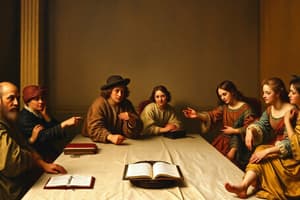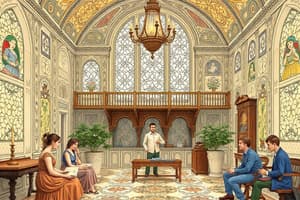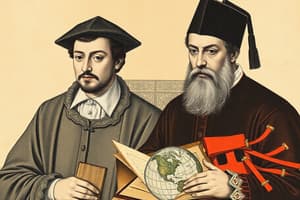Podcast
Questions and Answers
What was one of the social purposes emphasized by Renaissance pedagogues?
What was one of the social purposes emphasized by Renaissance pedagogues?
- Reinforcing monarchic rule
- Shaping and educating young individuals (correct)
- Advancing technological innovations
- Promoting global trade
Which Italian pedagogue is known as the 'Father of Physical Education'?
Which Italian pedagogue is known as the 'Father of Physical Education'?
- Hieronymus Mercurialis
- Maffeo Vegio
- Archange Tuccaro
- Vittorino da Feltre (correct)
What is a central theme in François Rabelais' work regarding education?
What is a central theme in François Rabelais' work regarding education?
- Academic achievements outweigh physical abilities
- The necessity of military discipline in education
- Rhetoric and grammar are essential without physical education (correct)
- Sedentarism enhances intellectual growth
What type of gymnastics did Hieronymus Mercurialis emphasize in his work 'De Arte Gymnastica'?
What type of gymnastics did Hieronymus Mercurialis emphasize in his work 'De Arte Gymnastica'?
Maffeo Vegio believed that exercise could prevent which of the following?
Maffeo Vegio believed that exercise could prevent which of the following?
What was one of the main beliefs held by Archange Tuccaro regarding acrobatics?
What was one of the main beliefs held by Archange Tuccaro regarding acrobatics?
Which concept did the Renaissance shift away from in favor of an anthropocentric vision?
Which concept did the Renaissance shift away from in favor of an anthropocentric vision?
What did Thomas Elyot emphasize regarding the effects of exercise?
What did Thomas Elyot emphasize regarding the effects of exercise?
Which Renaissance figure founded 'Casa Giocosa'?
Which Renaissance figure founded 'Casa Giocosa'?
Which of the following represents the scientific revolution linked to Renaissance thought?
Which of the following represents the scientific revolution linked to Renaissance thought?
Which of the following was proposed by Juan Luis Vives regarding physical education?
Which of the following was proposed by Juan Luis Vives regarding physical education?
What concept did Richard Mulcaster emphasize in his educational approach?
What concept did Richard Mulcaster emphasize in his educational approach?
Which Spanish pedagogue emphasized the link between physical training and spiritual improvement?
Which Spanish pedagogue emphasized the link between physical training and spiritual improvement?
What principle did Cristobal Mendez contribute to the field of physical education?
What principle did Cristobal Mendez contribute to the field of physical education?
What ancient game is closest in similarity to Kolf, as mentioned in the Renaissance context?
What ancient game is closest in similarity to Kolf, as mentioned in the Renaissance context?
Which principle did Jeronimo Sanchez de Carranza advocate for in fencing?
Which principle did Jeronimo Sanchez de Carranza advocate for in fencing?
What defines the goal of the Palio di Siena horse race?
What defines the goal of the Palio di Siena horse race?
Which physical activity allows only 1v1 combat as per the rules established in 1580?
Which physical activity allows only 1v1 combat as per the rules established in 1580?
What was a unique rule of Florentine Calcio regarding scoring?
What was a unique rule of Florentine Calcio regarding scoring?
Which activity was banned to prioritize archery training by several kings?
Which activity was banned to prioritize archery training by several kings?
What key aspect of Martin Luther's 95 Theses advocated for the relationship between the believer and God?
What key aspect of Martin Luther's 95 Theses advocated for the relationship between the believer and God?
Which of the following best describes the social perception of sports in Northern Europe during the Baroque period?
Which of the following best describes the social perception of sports in Northern Europe during the Baroque period?
What was a significant philosophical contribution of John Locke regarding physical education?
What was a significant philosophical contribution of John Locke regarding physical education?
Which of the following sporting activities originated from Native American tribes in the Great Lakes Region?
Which of the following sporting activities originated from Native American tribes in the Great Lakes Region?
In the context of physical education in the 17th century, which idea was NOT supported?
In the context of physical education in the 17th century, which idea was NOT supported?
What unique feature characterized the Cotswold Games?
What unique feature characterized the Cotswold Games?
Which sport was adapted in the 17th century in Scotland utilizing readily available materials?
Which sport was adapted in the 17th century in Scotland utilizing readily available materials?
What differentiation exists in the views of René Descartes compared to other philosophers regarding the body and education?
What differentiation exists in the views of René Descartes compared to other philosophers regarding the body and education?
What aspect of the sport Hurling was established in its first rules in 1602?
What aspect of the sport Hurling was established in its first rules in 1602?
Which key component distinguishes the fencing styles of various European cultures?
Which key component distinguishes the fencing styles of various European cultures?
What is the primary focus of Jean-Jacques Rousseau's educational philosophy in 'Emile'?
What is the primary focus of Jean-Jacques Rousseau's educational philosophy in 'Emile'?
How did Inmanuel Kant's educational approach differ from Rousseau's?
How did Inmanuel Kant's educational approach differ from Rousseau's?
What educational innovation did Johann Bernhard Basedow implement?
What educational innovation did Johann Bernhard Basedow implement?
What was Claude Adrien Helvetius's perspective on education?
What was Claude Adrien Helvetius's perspective on education?
What characterized the physical education philosophy during the Enlightenment period?
What characterized the physical education philosophy during the Enlightenment period?
What was a key development in the history of boxing as mentioned?
What was a key development in the history of boxing as mentioned?
Which statement about Johann Heinrich Pestalozzi's educational approach is accurate?
Which statement about Johann Heinrich Pestalozzi's educational approach is accurate?
What was the significance of the Marylebone Cricket Club in sports history?
What was the significance of the Marylebone Cricket Club in sports history?
What approach did Gaspar Melchor de Jovellanos advocate in the origin of sports associations?
What approach did Gaspar Melchor de Jovellanos advocate in the origin of sports associations?
Flashcards
Greco-Roman Knowledge
Greco-Roman Knowledge
The rebirth of classical knowledge and ideas from Ancient Greece and Rome that influenced the Renaissance.
Printing Press
Printing Press
The invention of the printing press allowed for the mass production of books, spreading knowledge and ideas more easily.
Socio-economic Transformation
Socio-economic Transformation
The Renaissance saw significant changes in society, including a shift towards a more capitalist economy and the rise of a wealthy middle class.
Wealthy Bourgeoisie
Wealthy Bourgeoisie
Signup and view all the flashcards
Scientific Revolution
Scientific Revolution
Signup and view all the flashcards
Resurgence of Physical Education
Resurgence of Physical Education
Signup and view all the flashcards
Humanist Movement
Humanist Movement
Signup and view all the flashcards
Theocentric to Anthropocentric Vision
Theocentric to Anthropocentric Vision
Signup and view all the flashcards
Positive, Active, and Enthusiastic Attitude towards Life
Positive, Active, and Enthusiastic Attitude towards Life
Signup and view all the flashcards
Understanding the Necessity of Physical Education
Understanding the Necessity of Physical Education
Signup and view all the flashcards
John Locke's 'Blank Slate'
John Locke's 'Blank Slate'
Signup and view all the flashcards
Sensory Approach to Learning
Sensory Approach to Learning
Signup and view all the flashcards
Scientific Based Training
Scientific Based Training
Signup and view all the flashcards
Costwold Games
Costwold Games
Signup and view all the flashcards
Lacrosse
Lacrosse
Signup and view all the flashcards
Hurling
Hurling
Signup and view all the flashcards
Curling
Curling
Signup and view all the flashcards
Billiards
Billiards
Signup and view all the flashcards
Pall-Mall
Pall-Mall
Signup and view all the flashcards
Fencing
Fencing
Signup and view all the flashcards
Richard Mulcaster's educational philosophy
Richard Mulcaster's educational philosophy
Signup and view all the flashcards
Mulcaster's system of physical education
Mulcaster's system of physical education
Signup and view all the flashcards
Desired effects of Mulcaster's physical education
Desired effects of Mulcaster's physical education
Signup and view all the flashcards
Saint Ignatius of Loyola's view on physical education
Saint Ignatius of Loyola's view on physical education
Signup and view all the flashcards
Juan Luis Vives' educational perspective
Juan Luis Vives' educational perspective
Signup and view all the flashcards
Cristobal Mendez and Sports Medicine
Cristobal Mendez and Sports Medicine
Signup and view all the flashcards
Scottish Golf (Gowk)
Scottish Golf (Gowk)
Signup and view all the flashcards
Fencing in the Renaissance
Fencing in the Renaissance
Signup and view all the flashcards
Florentine Calcio
Florentine Calcio
Signup and view all the flashcards
Equestrianism and Dressage
Equestrianism and Dressage
Signup and view all the flashcards
Absolute Monarchy
Absolute Monarchy
Signup and view all the flashcards
Enlightenment
Enlightenment
Signup and view all the flashcards
Enlightened Despotism
Enlightened Despotism
Signup and view all the flashcards
Naturalism
Naturalism
Signup and view all the flashcards
Rationalism
Rationalism
Signup and view all the flashcards
Philanthropism
Philanthropism
Signup and view all the flashcards
Natural Education
Natural Education
Signup and view all the flashcards
Emile
Emile
Signup and view all the flashcards
Natural Development
Natural Development
Signup and view all the flashcards
Education is Important for Behavior
Education is Important for Behavior
Signup and view all the flashcards
Study Notes
Renaissance
- Greco-Roman knowledge influenced the era
- Printing press played a key role
- Socio-economic changes included the rise of the wealthy bourgeoisie
- Scientific revolution marked a shift in thought
- Physical education experienced a resurgence with a humanist approach
- Theocentric views transitioned to anthropocentric views
- A positive and active attitude towards life was emphasized
- The importance of physical education was recognized
Pedagogues of Renaissance
- Pedagogues aimed to improve culture, spirit, soul, and personality
- Dualism and monism were debated as philosophical views
- Social purpose, military training, and health were key goals in education
- War's impact on the need for strong armies was important
- Hygienic and medical purposes were also considered
Italian Pedagogues
- Vittorino da Feltre was a prominent figure
Father of Physical Education
- Founded "Casa Giocosa"
- Incorporated Greek traditions and military education, catering to special education needs
- Maffeo Vegio's work on child development and behavior was important
- Believed that exercise could prevent psychological depression in children
Hieronymus Mercurialis
- Created "De Arte Gymnastica"
- Summarized philosopher's views on education, including Greek medical knowledge
- Athletic, military, and medical gymnastics were explored
Archange Tuccaro
- Served Charles IX as a "king's jumper"
- First illustrated book detailing acrobatic movements (roundoffs, twists)
- Believed in the medical benefits of these techniques
French Pedagogues
- François Rabelais's "Gargantua and Pantagruel" influenced ideas
- Many authors advocated for physical education
English Pedagogues
- Understood the physiological effects of exercise
- Thomas Elyot recognized exercise's role in digestion, body temperature, and metabolism
- Richard Mulcaster highlighted the importance of natural development in education
- Systematization of physical education became a focus
Physical Education in the 17th Century
- Emphasized physical aspects in education
- Considered natural development of human beings
Spanish Pedagogues
- Saint Ignatius of Loyola used physical education to fight against Protestantism
- Schools were encouraged to have designated play spaces
- Juan Luis Vives suggested reviving Greek gymnasiums
Proposal to Bring Back Greek Gymnasiums
- Cristobal Mendez, a pioneer in sports medicine, suggested adapting principles for PA
- Gender, age, location etc were important considerations given for classifying exercises
Physical and Sporting Activities of the Renaissance
- Scottish Golf (Gowk), a sport with similar roots, was mentioned
- Struck stones were used as clubs
Fencing
- Evolution of duel combats, chivalry training
- The use of swords became focused on art
- Fencing styles were categorized by origin and masters who influenced them
Florentine Calcio
- Evolution of Roman Haspartum football
- The rules from 1580 were influential
- 27 Players, 2 Teams were involved
Other Italian Ball Games
- Ball games were noted, like Pallone Col Bracciale, and Tamburello
Equestrianism
- Dressage, a type of equestrianism, was included
Palio di Siena
- Horse racing was a popular sport in Siena
- The goal was for the horse to pass the finish line
Historical Introduction (Renaissance)
- Political power transfers to absolute Monarchy from the Catholic or Protestant perspective
- Scientific Revolution was a backdrop
Reformation and Counter-Reformation
- Martin Luther's 95 Theses highlighted issues with Christianity
- The worship of saints and virgins was questioned
- Religious activity and the relationship with God were important topics
Main Features of Sports in Baroque
- Practiced in military, social, and cultural contexts
- Masculinity/Femininity were promoted through physical education
Sporting Activities of the 17th Century
- Cotswolds Olympic Games were mentioned as an event
- Robert Dover played a significant role
- A role of hammer throwing was recognized
Hurling
- Irish Gaelic sport dating back to 2000BCE
- Chaotic and violent style of play
- Important rules were established
- Was a prevalent sport
Curling
- Scottish sport in 1620
- Accessibility was a key factor in its creation
- On frozen rivers
- Rocks were a significant part of the sport
Billards
- Details explained in slides
Pall Mall
- Precursor to croquet, a popular sport
- Prevalent sport
Enlightenment
- Education was more inclusive
- Naturalism, Rousseau's views, etc.
- Emphasis on intelligence over wealth
- Subtle changes in ideology, and absolute Monarchy influenced the approach
- Some enlightened despots
Physical Education in Enlightenment
- Improvements in knowledge, critical thinking, and scientific thought shaped physical education
- Education broadened to include diverse backgrounds, naturalism, Rousseau, Helvetius, and Kant being important voices
- Philanthropism became a prevalent concept
- Curricula for education began to emerge
- Stages of development in childhood were recognized, and importance of senses and nature were highlighted
Other important figures in Enlightenment
- Claude Adrien Helvetius's views on human behavior included the importance of environment
- Jean-Jaques Rousseau's Natural Education included natural development, and steps involved in it.
- Johann Friedrich Guts Muths championed inclusive education
Other sports
- Boxing and its evolution, and other sports evolved in the era
- Professional Boxers were described, including their development in the era (rings, round systems, etc.)
- James Figg, and his involvement in boxing, was mentioned
- First regulation for teams was recognized in Cricket, including Women's cricket
- Marylebone Cricked Club (still exists today)
Pedestrianism
- Servants in carriages checked roads with racing pedestrianism
- Foot races were popular
Studying That Suits You
Use AI to generate personalized quizzes and flashcards to suit your learning preferences.




